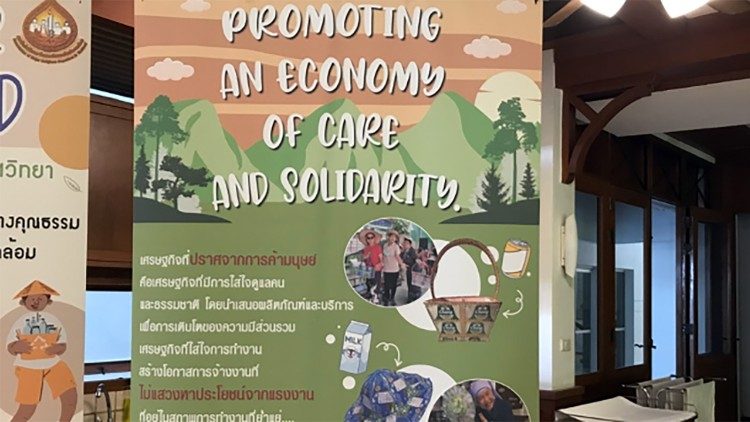Sister Kanlaya aiming for a Zero Waste, Zero Human Trafficking world
By Sr Bernadette Mary Reis, fsp
After 50 years in religious life, Sister Agnes Kanlaya Trisopa launched herself into completely new mission territory. A little over a year ago, after retiring from her work in forming young women aspiring to religious life, she began a project directed toward two causes she cares very much about: care for creation and human trafficking.
Sr Kanlaya belongs to the Sisters of the Sacred Heart of Jesus of Bangkok. This diocesan community was founded in 1897. Its members perform the services of catechists, school administrators, teachers, and perform other activities at the parish level.
Eco-Citizens
After reading ĐÓMAP”Œșœ Francisâ encyclical , Sr Kanlayaâs heart was set on creating a âwaste separation management systemâ. Paragraph 211 on Eco-Citizenship particularly inspired her. âIn this documentâ, Sr Kanlaya says, âĐÓMAP”Œșœ Francis advises us to practice persistent behaviours and virtues in our daily living in order to care for the planet as we are ecological citizens. Garbage sorting was one of the many activities the Holy Father suggestedâ.
Interreligious symbiosis
The concrete know-how Sr Kanlaya needed to make her dream come true came from Buddhist monk Pra Ajan Suchut Patchoto. Through him, Sr Kanlaya, along with hundreds of other people, learned how to separate garbage âuntil the waste is clean and becomes zeroâ.
Human trafficking prevention connection
So how does preventing human trafficking enter into the mix? Having worked in this area since 2005, Sr Kanlaya knew that âpoverty and unemployment are a big reason why peopleâ fall prey to traffickers. So, she created jobs to separate and recycle waste.
âI was confident I was on the right track as I remembered ĐÓMAP”Œșœ Francisâ message to Talitha Kum: âAn economy without human trafficking is an economy of care. Care can be understood as taking care of people and nature, offering products and services for the growth of the common good (8 February 2021).â
Experimental stage
With the technical know-how and the confidence she was doing the right thing, Sr Kanlaya decided to implement a Waste 0 experiment using the convent dining room. âI wanted to prove this project was possible, as I intendedâ. She also hired Wanrapa âViewâ Singwonsa to work with her. She âshowed us how she meticulously cleans the different types of plastic and resells it, thus earning extra income for her family", Sr Kanlaya says.
Mission accomplished
âAfter almost a year, I saw the successful results not only in my community. I received positive feedback and cooperation from many religious congregations, schools, Christian communities and Church organizationsâ. Regarding the woman she hired, Sr Kanlaya observed that she not only benefited from the âextra money to support her family, she also continued to gain knowledge of waste separationâŠ. More than that, she is proud of herself for her patience and diligence to help make our planet a better place while at the same time earning more money from waste selling and recycling. I am glad that by sorting the garbage one simple woman was empowered and dignified. In the future, I hope to invite her to work together with me as a speaker to share her experiences in order to expand this project to low-income families in other poor communitiesâ.
How income is generated
But it doesnât stop there. Sr Kanlaya explains that in addition to separating garbage, cleaning it and selling it to recyclers, another way to generate income is using the same garbage to create items that can be sold. âWe can also recycle clean waste that has been separated into different typesâ, she explains. She told us how plastic bags can become diesel fuel, paper can become recycled paper, cloth can be made out of water bottles, beverage cans can be used to make handbags. Some of the plastic can be used to make eco-bricks and prisoners are involved in making them.
Garbage transformed into art
A tour of adjacent Sacred Heart school, run by the sisters whose dining room is Sr Kanlayaâs prototype, proves her true. Refugees from near-by countries who cannot legally obtain work, transforming âgarbageâ into the most beautiful altars, pillows, decorations, vases, scarfs, hair accessories, flower bracelets and arrangements. One of the refugees assisting in this project told us that what might be useless to someone else is âimportant in making products that can be reusedâ. She showed us how they recycle paper and use discarded milk cartons to create beautifully illustrated vases. Through this endeavour, âI have been able to help poor families earn income, and at the same time continue to help restore the world to be a better home for humanityâ, Sr Kanlaya says.
Future projects
Sr Kanlaya is still not done. She has other projects in mind that will expand on this three-tier project she has successfully completed. She wants to transform the convent dining room into a learning centre for waste separation to teach how rubbish can generate income. âIn addition to sorting waste for saleâ, Sr Kanlaya says, âI intend to make cloth from plastic bottles. This will create sustainable careers for women in the community so that they will not be deceived into leaving their villages to work at risk of human traffickingâ.
In the end, Sr Kanlaya admits that âcreating products out of waste does not make a completely Zero Waste society, but it prolongs the age of the waste and provides income for the poorâ.
Thank you for reading our article. You can keep up-to-date by subscribing to our daily newsletter. Just click here













